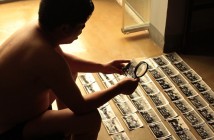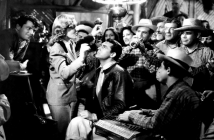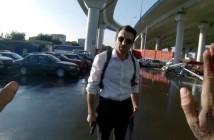
Editor’s Note: The following review is part of our coverage of TIFF’s The Crisis of the Real: New Chinese Independent Documentaries. For more information, visit tiff.net and follow TIFF on Twitter at @TIFF_NET.
As is expected by now from the Harvard Film Study Center + Sensory Ethnography Lab (SEL), this film co-directed by JP Sniadecki and Libbie Cohn is an immersive visual experience that allows the viewer to get to know a particular setting and how people interact with and/or use it. SEL films forgo an expository mode of documentary filmmaking where knowledge and/or information are conveyed primarily through the word and an accumulation of disparate audiovisual data via what Bill Nichols calls ‘evidentiary editing.’ Instead, SEL film such as Sweetgrass (2009, dir. Lucien Castaing-Taylor/Ilisa Barbash), Leviathan (2012, dir. Lucien Castaing-Tayler/Véréna Paravel), and Manakamana (2013, Stephanie Spray/Pacho Velez) have the unifying characteristic of planting a sustained, detached observational gaze on a specific location – shepherding through Montana’s Absaroka-Beartooth Mountains, working on a fishing vessel as it tears through the waters, and riding up and down a cable car in Nepal, respectively – and letting the location speak for itself through the varied persons who come into contact with it, whatever their reasons may be. Through this stubbornly unwavering and insistent but also open way of looking at/documenting a given space, SEL films capture often unexpected and marginalised perspectives. Such perspectives, then, become enriched with the diversity of experiences that flit through the camera’s gaze, which in turn also registers a rhythm of individual and collective way of being at a specific point in time.
People’s Park is no exception. Shot in one take on a Saturday in July 2011, with the camera mounted on a rolling wheelchair, the film meanders through the titular park located in Chengdu, Sichuan province, capturing the continuous ebb and flow of people and people watching. In this way, the film mirrors the very thing that it is documenting, which partly accounts for its magnetic quality. In this way, too, with the camera discovering different corners of the park in one continuous take, it unfolds like the Japanese narrative horizontal picture scroll known as emakimono, whose style of storytelling rests on the unrolling of the scroll and revelation of illustrations. Though choreographed and requiring multiple takes to arrive at the finished cut, the film nevertheless strikes a balance between strategic pre-planning and happenstance as it witnesses an endless parade of ages, faces, and movements. As if self-reflexively and subtly nodding to its mix of choreographed pre-planning and happenstance, dance and music emerge as a prominent component: images of people dancing or singing karaoke and music blasting at nearly each remove, like someone constantly switching a radio dial, populate the film from its opening to the closing ten minutes.
In a sense, the film itself is (shot) like a dance. When the camera’s gaze decides to follow a person who suddenly enters and crosses the frame, a shift in framing like a change in dance partners takes place, as does a new phase of exploration of the park. The park itself becomes a living entity through the camera’s unremitting gaze, revealing nooks and crannies of greenery, social spaces, and people making use of them. As if the camera takes on the subjective point of view of a dancer in the middle of a grand ballroom, it shows people mingling, standing by, watching something, looking back at the camera; in short, it shows a never-ending stream of people and space in constant interaction, in the shade or in the open air. At one point, where the bodies end and the space of the park begins (or vice-versa) becomes indistinguishable. Put another way, through the long take, one falls under the illusion that the space of the park is almost being carved out by the people’s movements and vice-versa, in a rather phenomenological sense. Or as philosopher Don Ihde once phrased it, ‘in ordinary terms, the phenomenological “I” takes on its significance through its encounter with things, persons, and every type of otherness it may meet.’ With this statement, Ihde expresses the singular intention and lure of SEL films like People’s Park.
Though no direct interaction between filmmakers, camera, and social actors in the form of interviews appear in the film, it must be understood that before shooting could take place a certain degree of interaction and trust between the filmmakers and the people at the park had to be established to make possible the shooting itself. Why SEL films like People’s Park make for mesmerising viewing is that they reject the all too common technique of the talking head to not only convey information but also express this interaction between filmmakers and social actors. While for some this sustained, non-interactive approach may bring SEL films like People’s Park between the threshold of remarkable and tedious, it is often the side of remarkable that wins out by film’s end, and such is the case with this one.
And while at first glance the film may strike a discordant note within the set of films constituting the TIFF series ‘Crisis of the Real,’ its place in the series is more than warranted in terms of staging encounters between local/international audiences and, in the words of series programmer Shelly Kraicer, ‘several “Chinas” – that they have never previously imagined,’ especially those ‘Chinas’ that result from ‘tizhiwai, filmmaking taking place outside the system.’



